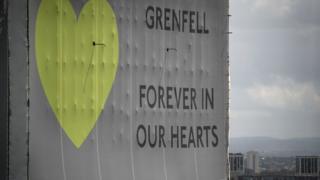Grenfell Tower: Government to pay £200m for safer cladding
 Image copyright PA
Image copyright PA The government is to cover the £200m bill of replacing Grenfell Tower-type cladding on about 150 private blocks in England with a safer alternative.
Housing Secretary James Brokenshire had previously said the bill should be footed by the owners, not the taxpayer.
But he acknowledged the long wait for remedial work to be carried out had caused anxiety and strain for people living in those high rises.
He said owners had been trying to offload the costs on to leaseholders.
Seventy-two people died when a fire destroyed Grenfell Tower, in west London, in June 2017, in one of the UK’s worst modern disasters.
It took minutes for the fire to race up the exterior of the building, and spread to all four sides.
A public inquiry into the fire heard evidence to support the theory that the highly combustible material in the cladding was the primary cause of the fire’s spread.
Latest government figures show that 166 private residential buildings out of the 176 identified with aluminium composite material (ACM) cladding – the same type used on Grenfell Tower – are yet to start works on removing and replacing it.
Mr Brokenshire admitted he had changed his mind on demanding freeholders pay up for safety work.
He said some building owners had tried to pass on the costs to residents by threatening them with bills running to thousands of pounds.
“What has been striking to me over recent weeks is just the time it is taking and my concern over the leaseholders themselves – that anxiety, that stress, that strain, and seeing that we are getting on and making these buildings safe.”
‘The stress is insurmountable’
Alex Di Giuseppe, a leaseholder in a block with unsafe cladding in Manchester, said the stress of living in the building had been “insurmountable”.
“We’ve been back and forth with the developer. We’ve been in contact with the freeholder as well – and obviously we’ve been working with the management agent.
“And, to be perfectly honest, we’ve got nowhere,” he said.
“It’s taken its toll on myself and a number of other leaseholders – obviously we’ve been living in an unsafe building and we’ve had these huge costs placed upon our heads. The stress is insurmountable at the moment.
“If this was a car with an airbag issue, it would be recalled. We don’t understand why it’s taken so long for the government to get to this point.”
Mr Brokenshire told BBC Radio 4’s Today programme: “We’ve seen a number of building owners and developers coming forward and doing the right thing.”
Pemberstone, Aberdeen Asset Management, Barratt Developments, Fraser Properties, Legal & General and Mace and Peabody were named as having fully borne the costs for their buildings.
Prime Minister Theresa May said: “It is of paramount importance that everybody is able to feel and be safe in their homes.”
Grenfell United, a group of survivors and the bereaved, said the news offered hope to people feeling at risk at home.
“This result is a testament to residents themselves, in social and private blocks, who refused to be ignored. The truth is we should never have had to fight for it,” the group said.
It asked the government to consider financial support for residents as they continue night watches and wait for the remediation work to begin.
Polly Neate, chief executive of the housing charity Shelter, said it was deeply concerning that dangerous cladding was still on buildings nearly two years after the Grenfell fire and that she hoped the work would be carried out quickly and effectively.
Last year, Stormzy and Adele joined Grenfell survivors in an emotional video calling on the government to remove dangerous cladding from buildings.
The government has already committed to funding replacement cladding in the social sector. There are currently 23 blocks still covered in it.
Owners of private buildings will have three months to claim the funds, with one condition being that they take “reasonable steps” to recover the costs from those responsible for the use of the cladding.




